When most travelers think of Laos, they imagine the sheer rock cliffs, lazy rivers, and green rice paddies that make up the North. Whether you start here by crossing over from Thailand to Huay Xai or use the North to end the Laos leg of your journey, one thing's for sure: allot plenty of time. The North's an easy place to get stuck, both because it's beautiful and because transportation is awful.
See and Do and Activities
Most travelers head this way with two goals: trek through primary forest and minority villages, and relax on a river. The former can be done from Luang Nam Tha, while Nong Khiaw, situated on the banks of the Nam Ou, offers as much river as anyone could possibly want.
There's no need to book a trek ahead of time. Simply show up in Luang Nam Tha and walk the main road. Trek operators post any commitments they have for the next day on whiteboards outside their offices and prices go down as the number of people in the group goes up. You'll have to decide whether you want to trek or kayak, visit the Nam Ha primary forest or ethnic tribes, stay overnight or only do a day. There are tons of combinations to choose from and if you haven't done a trek in SE Asia before, doing it here seems both affordable and interesting.
One of the best organizers we found was housed in the green house on the main strip. Forest Retreat Laos had reasonable prices (around $25/day) for multiday treks and they had pretty good reviews. Since we'd already done a group trek in Burma with mixed results, we decided to explore this region on our own.
TIP: Explore the outskirts of Luang Nam Tha on a motorbike
The countryside is much prettier than the main street will have you believe.

Within just a few kilometers, you can visit an abandoned temple, see fields of rice paddies, and chat with villagers of the Lenten tribe in Ban Nam Dee.
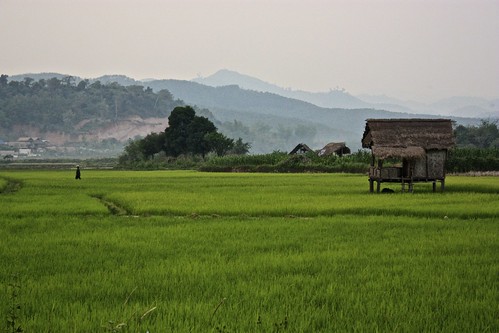
If you're lucky, you'll see how they dye their clothes from indigo. In the wet season the waterfall by their village is supposed to be impressive, but we skipped it since we heard it was nothing more than a trickle in April.
Doing a multi-day motorbike rental lets you go further afield, primarily to Muang Sing, a town 60m away and 10km from the Chinese border.
TIP: If you're motorbiking up, stop at the waterfall around 15km from Muang Sing
For 10,000K, you'll get a short trek through the protected primary forest. The falls themselves are pretty nice as well!
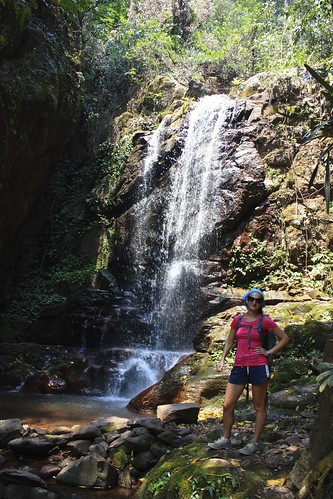
Muang Sing is another good place to arrange some trekking, though you can easily do it yourself there as well. In fact, staying at Adima Guesthouse on the road to China (about 8km from town) puts you less than a 5 minute walk from an Akha tribe village. If you're lucky, like us, you may just be invited to a wedding party that never seems to end!

Even if there's no wedding, there's still great trekking to be had by following the map Adima provides. If you do the whole loop you'll end up walking around 10 miles and passing several Akha and Yao tribe villages along with rice paddies, thatch resting huts, and TONS of banana plantations.
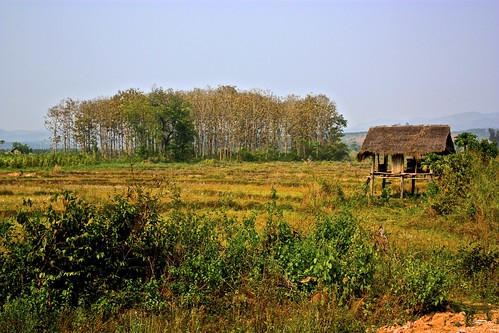
Your best bet for spotting traditional clothes is on older women. In the Akha villages, you'll see impressive headgear, and in the Yao villages, you might spot women wearing big furry red collars. How they do it in the heat is beyond me.
TIP: If you plan on visiting minority villages, bring a phrasebook
Simply saying, "My name is..." in the local language is often enough to make a lot of new friends.
Another thing you might notice in Muang Sing are the trucks full of trees, all heading out to China. The deforestation of Laos is a sad thing to witness and it's even sadder that most of the locals don't seem to realize that selling their land to China will hurt them in the long-term. Truck after truck lines up at the border, coming back empty to collect more wood.
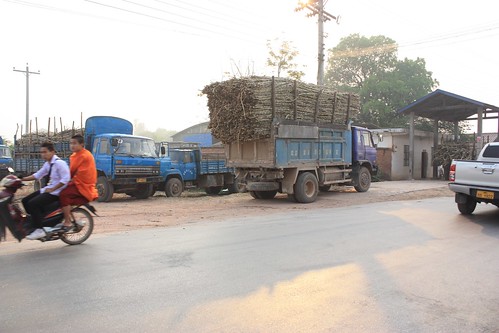
Most of the money from this likely goes to a few government officials who broker the deals. The only benefit most locals see are in the roads. Thanks to China, the roads in this part of the country, though windy, are well-paved and free of potholes. That way the trucks can go faster.
If you're looking for a relaxing time or want to follow your trekking with some hammocking, then Nong Khiaw and Muang Ngoi are for you. Both towns are situated on the banks of the Nam Ou and surrounded by limestone karsts covered in vegetation. The views here are probably the best we had in Laos and that makes up for the fact that there isn't much to do besides enjoy them.
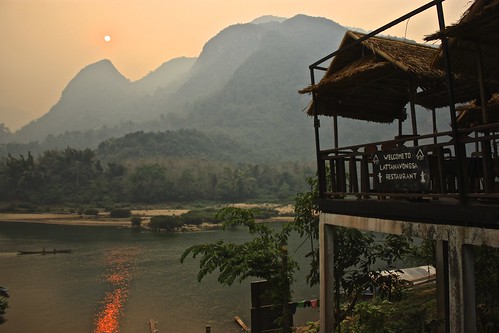
Finding a bungalow with a river view and chilling out is by far the most popular activity, though many travelers also walk to nearby caves and visit local villages. The cave and villages outside Muang Ngoi weren't that impressive, and we sort of wished we had more time in Nong Khiaw because we heard great things about the cave there. Still, the small beach on Muang Ngoi did provide a nice respite from the afternoon heat.
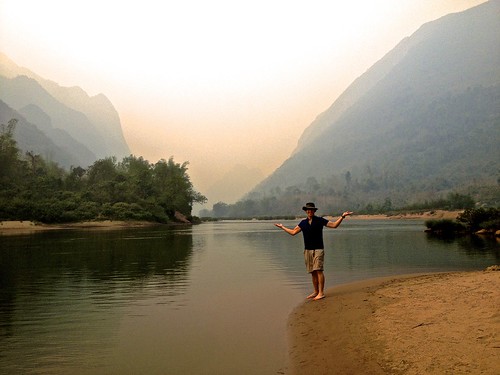
TIP: If you're feeling super lazy (or super hot), rent a tube
For 10,000K, you can float around the beach or pay more money to be taken upriver by boat.
Despite having few attractions, Muang Ngoi is an interesting place, if only because it's changing so rapidly. Until a few months ago, it was only reachable by boat (25,000K) from Nong Khiaw, but a few weeks before we arrived the locals completed a dusty albeit working road that now links the town by land. Given that the main appeal of this one street town was its isolation, we wondered whether Muang Ngoi's heyday would soon come to an end. The locals didn't seem to share our worries and were in fact installing power lines during our visit to provide 24 hour electricity. (Right now, there's only generator power for a few hours a night.)
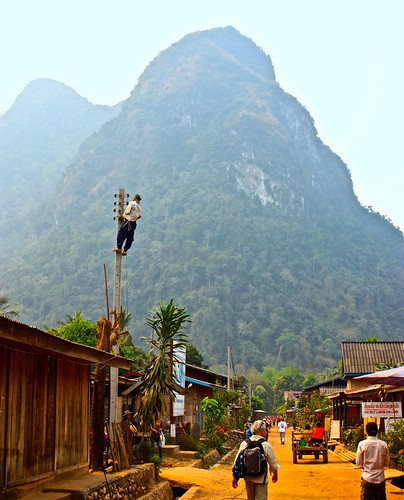
By the time you get to Laos, Muang Ngoi might not be what you thought. If that's the case, we hear there's another town a few minutes north by boat that's the Muang Ngoi of years past.
Overall, the North is a nice place to spend a week, though some travelers end up spending a lot more. In dry season, the landscape scenery wasn't as impressive as we had hoped it would be, but I imagine if you come right after the rains stop that the electric green fields of rice paddies alone would make it worth the trip.
Sleep
The border town of Huay Xai has a lot of cheap guesthouses and one unique one: Dauuw Home. Located on a dirt road above the main strip (turn left halfway up the stairs leading to the monastery), Dauuw provides bungalows that actually make you feel like you're in Laos. At 80,000K, they're far from the cheapest place in town, but all proceeds go to the nonprofit that runs the place and allows them to continue providing education, housing, and adequate healthcare to local tribal women.
In Luang Nam Tha, we stayed at Khamking Guesthouse. It was nothing special and one of our showers didn't have working hot water, but it was fairly clean and cost only 70,000K.
In Muang Sing, we opted for Adima Guesthouse outside of town. The bungalows were beautiful and we watched grazing water buffalo from our balcony. We paid 55,000K per night for two nights.
TIP: Staying more than one night? Ask for a (slight) discount
Most likely, you'll get it.
There are some upmarket places to stay in Nong Khiaw, but because we were only there for one night, we chose a simple bungalow at Bamboo Paradise. It was 50,000K and had a river view, though it wouldn't have been the view we chose if we stayed for an extended time.
Our bungalow in Muang Ngoi may have had a name, but we never learned what it was. Regardless, it looked over the river and had a nice sized balcony, though there wasn't a hammock and the showers were cold water. It was fine for 50,000K/night and the bed was comfortable.
Eat and Drink and Drink
Switching to Lao food after Thailand is tough. Street food tends to be either super spicy (we had to throw out the papaya salad we bought in Huay Xai) or incredibly bland (just watch how much sauce the locals put into their noodle soup.) Whether Laos lacks the spices or the creativity that Thai chefs employ is unclear, but nothing in the first week really blew us away.
Some highlights were the whole grilled fish at Dauuw Home, the fried tofu at Adima (seriously the best tofu ever!), and the Indian dinner we had in Nong Khiaw. Alex's restaurant in Nong Khiaw also served a delicious and well-priced traditional Lao breakfast that Rob loved. The spicy eggplant dip was our favorite Lao accruement and we ended up ordering it several times during our stay in the country.
Buffets are the name of the game in Muang Ngoi. For 20,000K, you get a plentiful breakfast and dinner buffet. It's all vegetarian and none of the dishes will blow your mind, but it is filling—and leaves you lots of cash for all those BeerLaos!
Transport
UGH. My impression of Lao transport started badly and didn't improve throughout our 3+ weeks. All the horror stories you hear are probably true, so it's best to come prepared, with plenty of patience and water.
It started in Huay Xai, when nobody could (or would) tell us when the bus to Luang Nam Tha actually left. I assume they all wanted commission from a sold ticket. We finally understood that it was either 9 or 9:30 and after the tuk-tuk ride to the station (100 baht) at 8:30, we were proven correct: bus left at 9:30. We bought our 60,000K ticket, got on the bus, and waited. At around 10:30, we got off the bus and asked why it hadn't left at. The man at the ticket office said, "No bus at 9:30 today. Bus leave at 12:30."
TIP: Welcome to Laos
If not enough people buy tickets, the transportation won't leave. And they won't tell you it's not leaving until you ask.
The trip from Luang Nam Tha to Nong Khiaw was probably the worst we've had so far. It took us about 10 hours to go approximately 240 kilometers, and it was a stressful, sweaty, and dusty 10 hours at that. It started well enough with our bus to Udomxai (60,000K), which both left and arrived on time. But that's where the good ended. The sign above the ticket stand said there was a bus to Nong Khiaw (giving me temporary joy), but the ticket seller informed me that it wouldn't be leaving until the following morning. Remembering that Pak Mong was on the way and seeing it listed as a destination, I asked for a ticket there (30,000K) and was told that the bus departed at noon. It was 11:30. I thought it was my lucky day.
We put our packs on top of the minibus and bought snacks for the road. Around 12:30, we asked when the bus would be leaving. The driver said 1. Not bad. At 1, we asked when the bus would be leaving, and again the driver said "1." It was then that we understood that the bus wouldn't leave at 1, but that it would wait until 1 more person showed up before it would leave.
At 1:15, someone did show up, but he brought his entire extended family with him. The driver piled 20+ people into a 15 person minivan and we were off for the bumpiest and dustiest three-hour ride of our lives. The locals thought it was hilarious to have tourists in the minibus with them and kept pointing to Rob's knees as they hit the seat in front of him and his head as it bumped the top.
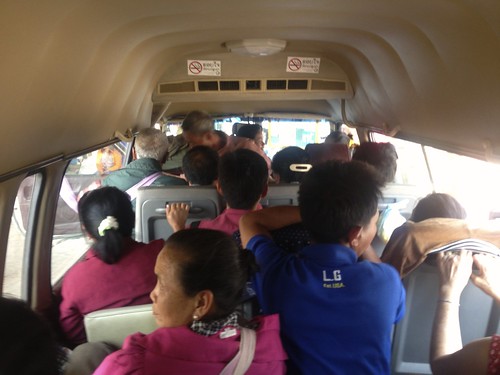
The trip ended well. When we arrived at Pak Mong a miracle minibus met us and took us to Nong Khiaw (20,000K, though he tried to charge 25,000K). It took about 1.5 hours, though that included a stop at a market that sold dead squirrels and bat shish kebab.
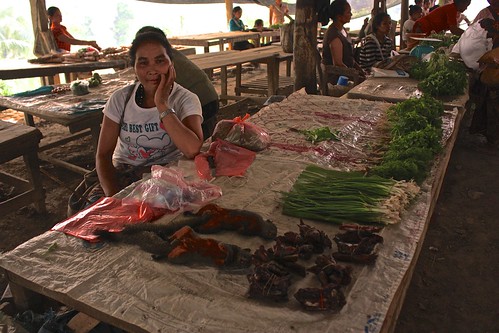
TIP: Traveling from Nam Tha to Nong Khiaw? Opt for a minivan
Travel in the North isn't always horrible, especially if you do things on your own. For instance, our 3 day motorbike rental in Luang Nam Tha cost us 50,000K/day, and that was for a Suzuki.
TIP: For longer trips, opt for a bike that isn't Korean or Chinese
You've been warned!
The 10 mile boat trip from Nong Khiaw to Muang Ngoi costs 25,000K and takes about an hour. When we went, the boat left at 11am daily. It was a beautiful ride amidst the limestone karsts and worth the money just for the views: locals gathering seaweed, children fishing, and water buffalo bathing.
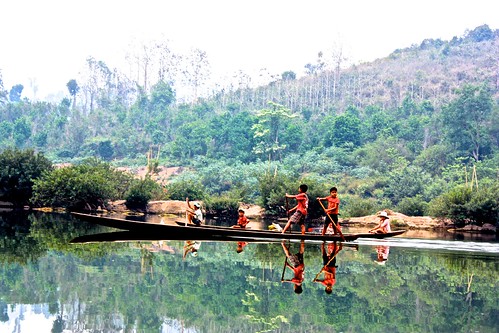
If you want more of those views, you'll want to opt for the boat (as opposed to bus) down to Luang Prabang. The boat leaves daily at 11am and costs 110,000K, though only if there are enough people. The day we wanted the boat, there were only 7 of us, so we negotiated to pay 150,000K each. For that, we got a ton of legroom and comfortable minivan-like seats as opposed to hard benches. The six hour ride was beautiful and much nicer than a bus trip, especially with our upgraded seats. As part of the negotiation, the boat driver also agreed to let us stop at Pak Ou, caves near Luang Prabang that house thousands of Buddhas. At 20,000K, the caves were overpriced for what they were.
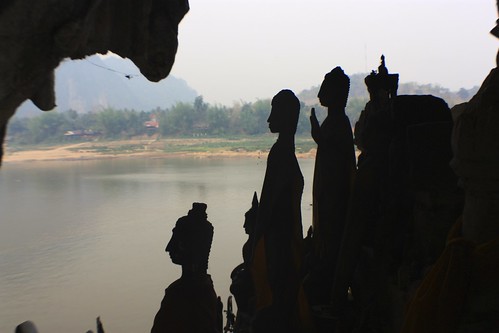
More Northern Laos
Interested in seeing Muang Sing and Nong Khiaw without paying for a plane ticket? Check out our Northern Laos photo tour.
If you have any tips for backpacking Northern Laos, please leave a comment!
Comments